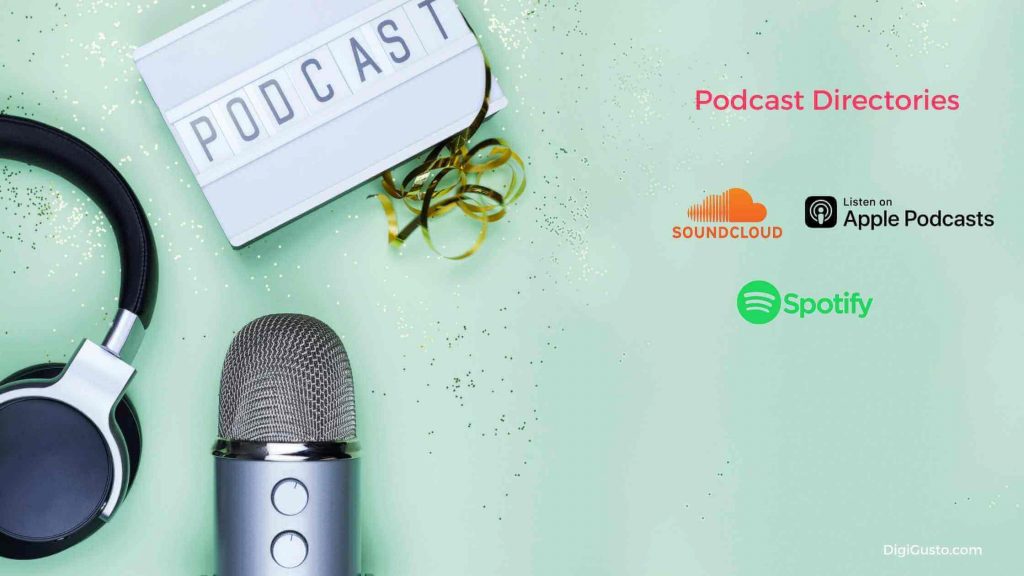Podcast Marketing is an act of marketing the podcast. The podcast in simple terms is an honest interview with a guest or yourself talking to an audience on certain topics. Podcast in a new age marketing term where one dives into deep conversation with the guests and audiences candidly. It is a form of the interview but more in a casual and formal manner.
Why podcast marketing?
While podcast can look boring, it has their own set audience. The podcasts are highly educational and made for a niche audience. With the increase of platforms like Spotify, and having a huge number of listeners, the rise of podcast listeners has begun. Podcasts do not have to be on a video platform, where you need to sit down and watch the video. The audio podcasts can be listened to anywhere anytime, without the need of being still and glued to the screen. Thus, the podcast popularity is increasing and it is beneficial for businesses to create a podcast and do podcast marketing for a niche audience.
Podcasts can look like a conversation, but there are many ways for you to market your business. Some of them we will talk about as the blog progress.
11 Marketing strategies for Podcasts
1. Know your audience
Before starting a podcast, know who is your audience, and what they want? Do you even have an audience for the niche you are making content for? Know what your goals are, do you want to share knowledge, because you love the topic or you are looking to promote your business? All the starting strategies are crucial factors in creating and marketing podcasts.
2. Content Creation Essentials
As the number of internet users has increased, the number of content creators in any space has increased too. Similar is the case for podcast creation. The podcasting space has been crowded as well. Podcasts mainly listen in audio format, thus its production and the sound quality need to be bearable for the audience to listen. One should not have outside noise and have engaging content. Getting a good microphone and editing software is a must before creating content. Afterward, you can think of a story, and create a plan on what you will talk about and how you will build a strong Call to Action (CTA).
3. Optimize, Optimize, Optimize
Again, no matter what the platform is if you are releasing on the web, optimization is important. Your titles and descriptions should be on point. An enticing heading will always catch the eyeballs. However, do not mislead people too often that your bounce rate increases. Do not write episode numbers only as your title, it doesn’t tell any story. An episode number with a title is always interesting to click.
4. Planning content
Think of content as you want to create episodes like a series or is it going to be a continuous weekly and daily affair. Plan the contents ahead. In the beginning, it is wise to understand the audience, so try testing your content. I listen to a lot of podcasts and I search for podcasts in different niches and terms. When I finally get a podcast I want to listen to, I only find one content posted and they have stopped posting it. If you plan to be successful in any form of content, the idea is to keep learning from mistakes and bring valuable content. But do not give up with content, as it doesn’t bring tons of subscribers and following in the longer run.
5. Let’s update the Website
Podcasts can be used for a strong Call to Action (CTA). Websites are easily sharable and they can not only contain your podcasts but different other content and services your offer. Depending on which host you use, podcasts can be hosted on your website, or can easily be embedded in any of your posts. Do not forget to create an about section on your website, including various other products and services you offer. If you can create a blog on the podcast and share your podcast on the blog itself will also be a great move for engaging the audience.
6. Search Engine Optimization
As I mentioned, creating an SEO-friendly title and description is very important for podcasts. Similarly, when you host your podcasts on your own website, it is a little more work. On other platforms, their algorithm does the work for you, like YouTube content, but on your website, you have to work on your own. Learn more about SEO on your website and optimize your website content for search engines. Make your on-page optimization and off-page optimization strong.
7. Newsletters
There have been debates on whether newsletters do not work. However, I would not agree to this, as newsletters are only subscribed by people who show a keen interest in your brand. There are high chances that the subscribers open those emails if they do not look like spam mail. Email marketing is crucial for any business and you should start growing your email lists from the beginning.
8. Podcast Directory Submission
There are various platforms where you can submit your podcasts. Each platform has its own audience, the more directories you submit, the more reach there will be. Unless you want to stick by only one platform of your choice because you are tied to that brand, like Spotify Exclusive. Platforms like Apple Podcasts, Spotify, and Soundcloud are quite popular and there are many more other platforms you can choose to host your podcasts. Once you create an account on these platforms, you have the opportunity to submit RSS to each platform automatically to reach a broader audience.

9. Engagement
Like in YouTube videos, it is important to ask your audience to like, share, subscribe, and leave reviews on your podcast. They will help you grow much faster. There is nothing wrong is asking your subscribers for the following to help you grow. When your content is great, audiences will follow your words too.
10. Having guests on your Podcasts
Podcasts can be created by self-talking about your own experience, however, once in a while, it’s good to have a guest in your niche. It will help you reach a greater audience and your audience will also get to know more about the topic from different perspectives. In my own experience, when I get to hear different voices listening to podcasts, I enjoy it a lot more. It gives me ideas on the same topic with a different mindset and helps me to understand the topic even deeper. And that’s the motive of podcasts, to help you dig deeper into the topics.
11. Share on Social Media
Starting by sharing your content on social media can be a great benefit to engaging an audience. However, only sharing the content won’t work. Creating a social media presence strategically can be beneficial in the longer run. Also, customize the content for every social media platform as audiences are very different from each platform.

